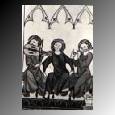 Music Bibliography at IUP
Music Bibliography at IUP
MUSIC SUBJECT HEADINGS
I. Music Subjects Headings have to cover two types of materials:
1. The music itself (M's) and
2. Books written about music (ML's and MT's)
With musical form subject headings, if it is in the
PLURAL,
it usually retrieves THE MUSIC ITSELF.
If it is the SINGULAR, it retrieves BOOKS ABOUT THAT SUBJECT
as a musical form. For example:
Sonatas will retrieve sonatas
Sonata will retrieve books about the sonata
Concertos will retrieve concertos
Concerto will retrieve books about the concerto
Symphonies will retrieve symphonies
Symphony will retrieve books about the symphony
Operas will retrieve opera scores
Opera
will retrieve books about the opera
This works for most musical forms. One exception is Songs. There is no singular subject heading song for books about this musical form. You will have to use the heading:
Songs--History
and criticism
II. All subject headings may be subdivided topically, chronologically or geographically. These subdivisions follow specific patterns. The full pattern is given for only one subject heading in any given field, since the other subject headings will follow the same pattern. For music, that heading is:
Operas
--
[topical,
form, chronological, geographic, free form subdivisions]
III. Musical forms for STANDARD COMBINATIONS OF INSTRUMENTS are under their SPECIFIC NAME.
NON-STANDARD COMBINATIONS are under more GENERIC
HEADINGS
with SPECIFIC INSTRUMENTATION IN PARENTHESES. For example:
Standard Combination Subject Heading
music for 2 violins, viola and violoncello String quartets
music for piano, violin and
violoncello
Piano trios
Non-standard combination Subject Heading
music for flute, guitar,violin and viola Quartets (Flute, guitar, violin, viola)
music for piano, tuba and
violin
Trios (Piano, tuba, violin)
IV. When a specific music form is not implied, the name(s) of the instrument(s) are given with the word "music." For example:
music for solo unaccompanied viola Viola music
music for oboe and piano
Oboe and piano music
V. When the relationship between the instruments is that of solo and accompaniment, the word "with" appears:
trombone solo with band accomp. Bass trombone with band
trombone concerto with band
accomp.
Concertos
(Bass trombone with band)
VI. Vocal music may be found
under the general term Vocal music, and ensembles with the term
Vocal, such as: Vocal duets, Vocal trios, Vocal
ensembles, etc.
Rather than soprano, alto, tenor or bass, vocal music subject headings
refer to
High voice, Medium voice and Low voice. Their approximate
relationship with standard vocal categories is as follows:
soprano and tenor: High voice
mezzo-soprano, alto and baritone: Medium voice
contralto and bass: Low Voice
If vocal music is in some kind of medium, such as "Songs", "Sacred Songs" or "Vocalises" (wordless songs), it will be found under that heading. For example:
solo soprano
accompanied by
string
orchestra Songs (High voice) with string orchestra
solo bass singing a sacred
text,
accompanied by
piano
Sacred songs (Low voice) with piano
solo alto singing without
words,
accompanied by an
orchestra
Vocalises (Medium voice) with orchestra
VII. The Library of Congress Subject Headings (LCSH) use bold face for a proper subject heading. It also contains cross references which will guide you to the most correct heading, using the following codes:
USE = Use the heading referred to
UF = Used for (DO NOT USE these headings)
BT = Broader term
RT = Related term
SA = See also
NT = Narrower term
Page created and maintained by Carl Rahkonen.
© 1987- Last modified 5/29/15
Comments and/or suggestions may be e-mailed
to: rahkonen@iup.edu.
Page hosted by the Indiana University of
Pennsylvania Libraries.